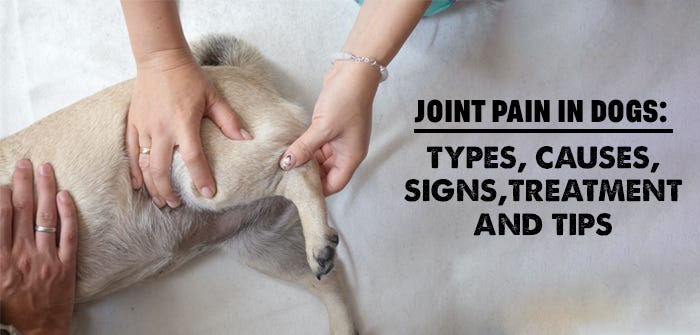Signs of joint pain in dogs can include limping, stiffness, loss of appetite, irritability, and frequent slipping while moving. Developmental and degenerative issues are the main causes of joint pain in dogs, with conditions like elbow or hip dysplasia potentially leading to more serious injuries.
Treatment options for joint pain in dogs include weight management, exercise, physical therapy, pain medications, and heat or cold therapy. Neurological conditions like degenerative myelopathy and intervertebral disc disease can mimic arthritis in dogs, causing similar symptoms such as weakness and changes in gait.
It’s important to look out for these signs and seek appropriate treatment to improve your dog’s quality of life.
Recognizing Joint Pain In Dogs
Joint pain in dogs is a common issue that can significantly impact their quality of life. It’s important for pet owners to be able to recognize the signs of joint pain in their dogs so that appropriate action can be taken. Here are some key indicators to watch out for:
Developmental Joint Issues
Developmental joint issues are present in your dog from their birth. These issues are generally caused by genetic problems, leading to improper joint development. Conditions like elbow or hip dysplasia are examples of more serious injuries this could lead to down the line.
Degenerative Joint Issues
Degenerative joint issues involve the gradual deterioration of the joint over time. This can be caused by aging, wear and tear, or previous injuries, leading to conditions like osteoarthritis.
- Lethargy
- Limping and stiffness
- Loss of Appetite
- Irritability
Awareness of these signs is crucial as it can help in timely detection and initiation of appropriate treatment. By recognizing these symptoms and understanding the different types of joint issues, pet owners can take proactive steps to ensure their dog’s well-being and comfort.

Credit: medium.com
Symptoms Of Joint Pain
Symptoms of joint pain in dogs include lethargy, limping and stiffness, loss of appetite, irritability, depression, and frequent slipping while moving. These symptoms may be caused by various factors such as genetics, developmental joint issues, or conditions like elbow and hip dysplasia.
Treatment options for dog joint pain include weight management, exercise, physical therapy, pain medications, and supplements.
Lethargy
One of the primary symptoms of joint pain in dogs is lethargy. If your furry companion is showing signs of increased fatigue and lack of interest in regular activities, it could indicate joint discomfort.
Limping And Stiffness
Limping and stiffness are noticeable indicators of joint pain in dogs. If you observe your dog experiencing difficulty while walking, running, or standing up, it may be a sign of joint issues.
Loss Of Appetite
Another concerning symptom is loss of appetite. If your dog is showing disinterest in food or experiencing a significant decrease in eating, it could be related to joint pain.
Irritability
Irritability can also be a sign of joint pain in dogs. If your normally jovial pet becomes easily agitated or displays signs of discomfort when handled, joint issues may be the cause.
Depression
Depression in dogs can be linked to joint pain. If you notice a change in your dog’s demeanor, such as increased sadness or withdrawal from activities, it may be due to joint discomfort.
Frequent Slipping
Frequent slipping while moving is another indication of joint pain in dogs. If your dog is having difficulty maintaining stability or seems unsteady, it could be due to joint issues.
Types Of Joint Pain In Dogs
Elbow Dysplasia
Elbow dysplasia is a common joint disorder in dogs, particularly larger breeds. It is characterized by the abnormal development of the elbow joint, leading to pain, lameness, and reduced mobility.
Hip Dysplasia
Hip dysplasia is another prevalent joint issue in dogs, especially in breeds with a genetic predisposition. This condition involves the malformation of the hip joint, causing discomfort, difficulty in movement, and eventual arthritis.
Cartilage Deterioration
Cartilage deterioration in dogs’ joints is a degenerative process where the cartilage, which acts as a cushion between bones, wears down over time. This leads to inflammation, pain, and reduced joint function.
Tendon Damage
Tendon damage can result from repetitive stress, trauma, or aging in dogs. When tendons become damaged, it can cause pain, stiffness, and limited range of motion in the affected joint.

Credit: www.michigananimalhospital.com
Causes Of Joint Pain
Joint pain in dogs can be caused by various factors that affect their mobility and overall quality of life. It is important to understand the different causes of joint pain in order to provide appropriate treatment and care for your furry friend.
Genetic Issues
Some dogs are prone to developing joint pain due to genetic issues. These issues are present from birth and can cause improper development of the joints. Examples of genetic issues that can lead to joint pain include elbow or hip dysplasia. These conditions can result in more serious injuries and discomfort as the dog grows older.
Osteoarthritis
Osteoarthritis is one of the most common causes of joint pain in dogs. This degenerative joint disease occurs when the cartilage that cushions the joints gradually wears away, causing pain, inflammation, and stiffness. As dogs age, their risk of developing osteoarthritis increases. However, it can also be caused by factors such as obesity, trauma, or overuse of the joints.
Injuries
Injuries, such as fractures, ligament tears, or sprains, can also lead to joint pain in dogs. These injuries can occur due to accidents, falls, or excessive strain on the joints. In addition to acute injuries, chronic repetitive injuries from activities like high-impact exercising or performing repetitive movements can also contribute to joint pain. It is important to provide proper care and rest for your dog if they experience any type of injury to prevent further joint damage.
Understanding the causes of joint pain in dogs is crucial for early detection and effective treatment. By identifying the underlying factors contributing to your dog’s joint pain, you can take the necessary steps to alleviate their discomfort and improve their overall quality of life.</p
Diagnosing Joint Pain
When it comes to diagnosing joint pain in dogs, various methods are used to determine the underlying cause and severity of the condition. Understanding the diagnostic procedures is crucial for early intervention and proper management of joint pain in our furry companions.
Physical Examination
A physical examination is the initial step in diagnosing joint pain in dogs. Veterinarians assess the range of motion, gait, and palpate the affected joints to evaluate swelling, tenderness, and any abnormalities. Observing the dog’s movement and behavior during the examination provides valuable insights into the extent of discomfort and limitation.
X-rays
X-rays, also known as radiographs, are commonly employed for diagnosing joint issues in dogs. This imaging technique allows veterinarians to visualize the internal structures of the joints, including bones, cartilage, and surrounding tissues. X-rays help identify bone abnormalities, joint degeneration, and signs of arthritis, aiding in a more accurate diagnosis.
Blood Tests
Blood tests are utilized to assess inflammatory markers and immune responses in the dog’s body. Elevated levels of certain proteins and enzymes in the blood can indicate the presence of autoimmune disorders or underlying systemic conditions that contribute to joint pain. These tests assist in ruling out infectious diseases and identifying potential causes of joint inflammation.

Credit: www.denvervet.com
Treatment Options
When it comes to treating joint pain in dogs, there are several options available. Each treatment option plays a crucial role in managing and alleviating your furry friend’s discomfort. Here are some effective methods to address joint pain in dogs:
Weight Management
- Ensure your dog maintains a healthy weight to reduce pressure on their joints.
- Consult with your veterinarian to create a balanced diet and exercise plan.
Exercise
- Engage your dog in low-impact exercises like swimming to improve joint mobility.
- Regular, gentle walks can also help strengthen muscles and joints.
Physical Therapy
- Consider physical therapy sessions to enhance your dog’s range of motion and strengthen muscles.
- Therapeutic exercises and modalities can aid in improving joint function.
Medications
- Your vet may prescribe pain medications to alleviate discomfort and inflammation.
- Anti-inflammatory drugs help reduce swelling and pain associated with joint issues.
Supplements
- Include joint-supporting supplements like glucosamine and chondroitin in your dog’s diet.
- Omega-3 fatty acids can also provide anti-inflammatory benefits for joint health.
By incorporating these treatment options, you can help manage your dog’s joint pain effectively and improve their quality of life.
Preventing Joint Pain
Spotting signs of joint pain in dogs is crucial for their well-being. Look out for symptoms like lethargy, limping, loss of appetite, irritability, and frequent slipping. Treatment options include weight management, exercise, physical therapy, pain medications, and supplements.
Proper Nutrition
Proper nutrition plays a crucial role in preventing joint pain in dogs. A balanced diet rich in essential nutrients such as glucosamine and omega-3 fatty acids can help maintain healthy joint function. Additionally, maintaining a healthy weight through proper feeding can alleviate the strain on a dog’s joints, reducing the risk of developing joint issues over time.
Regular Exercise
Regular exercise is vital for preventing joint pain in dogs. Low-impact activities such as swimming or gentle walks can help strengthen muscles surrounding the joints and maintain flexibility. It’s important to tailor the exercise routine to your dog’s age, breed, and current health condition, ensuring it promotes joint health without causing excessive strain.
Scheduled Vet Check-ups
Scheduled veterinary check-ups are essential for preventing joint pain in dogs. Regular examinations allow the veterinarian to monitor joint health and detect any early signs of joint issues. Additionally, they can provide specific recommendations for your dog’s needs, including dietary adjustments, exercise regimens, or supplements to support joint health.
Frequently Asked Questions
What Is The Most Common Joint Disorder In Dogs?
The most common joint disorder in dogs is osteoarthritis, a degenerative condition affecting the joints.
When Do Dogs Start Getting Joint Problems?
Dogs can develop joint problems due to developmental issues caused by genetics. Conditions like elbow or hip dysplasia can be present from birth. Such issues could lead to more serious injuries down the line. Watch for signs like limping, stiffness, and loss of appetite.
How Do You Fix A Dog’s Joint Pain?
To fix a dog’s joint pain, you can: 1. Manage weight 2. Provide exercise 3. Use physical therapy and hands-on techniques 4. Use recommended medications, injections, and supplements 5. Apply heat and cold therapy.
What Can Mimic Arthritis In Dogs?
Neurological conditions like degenerative myelopathy and intervertebral disc disease can mimic arthritis in dogs. These conditions can cause weakness, unsteadiness, changes in gait, and pain. It’s important to properly diagnose the underlying cause of joint pain in dogs for effective treatment.
Conclusion
Joint pain in dogs is a common issue that requires attention. Knowing the signs, causes, and treatment options is crucial. Whether it’s through weight management, exercise, or medication, helping your furry companion live comfortably is essential. Stay vigilant for any symptoms and consult a veterinarian promptly for proper care.



